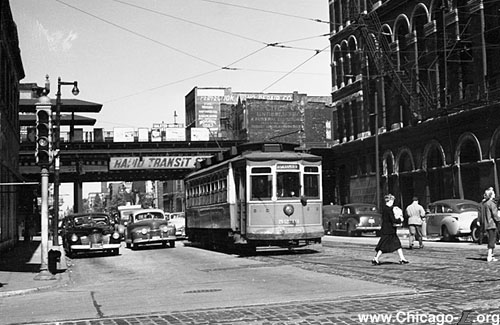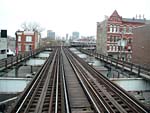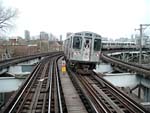|

Big Brill streetcar 5233 has just passed under the North Side main line elevated tracks and Halsted station platforms on its way to 111th and Sacramento on September 25, 1948. The streetcar is approaching North Avenue, with the famous Yondorf Block and Hall -- the Gothic-Victorian building, built in 1887, was an important community center for several generations of Chicagoans of German descent and was landmarked by the city in 2001 -- on the right. The Hasted station's platforms extend over the street, but the platform canopies just peak out from the west building line, so a large sign was erected over the street to provide better visibility and system identity. The station would be closed less than a year after this photo was taken. For a larger view, click here. (Photo by Fielding Kunecke, W. R. Keevil Archive)
|
Halsted (800W/1600N)
Halsted Street and North
Avenue, Lincoln Park
Service
Notes:

|
North Side
Division
|
Quick Facts:
Address: 1618 N. Halsted Street
Established: May 31, 1900
Original Line: Northwestern Elevated Railroad
Previous Names: Halsted & North
Skip-Stop Type: n/a
Rebuilt: n/a
Status: Demolished
History:
Halsted was built as part of the original main line of the
Northwestern Elevated in 1900. The only line in Chicago to do so, the
Northwestern "L" built four tracks north of Chicago Avenue to allow
for both local and express service. Some stations, like Halsted, were
built with two island platforms, each between two of the four tracks,
to facilitate both express and local trains and cross-platform
transfers, but some had only side platforms on the outside tracks
(for locals only).
The headhouse was one of several stations built from a design by
William Gibb on what is now the Brown Line. Constructed entirely of
brick with terra-cotta trim, the Classical Revival design was
inspired by the work of the great 16th century Italian Renaissance
architect Andrea Palladio. The bold modeling of the details,
especially the columns and segmented arched windows, is
characteristic of Italianate work of the late 19th century. The
interior featured plaster walls with extensive wood detailings in the
door and window frames, ceiling moldings, and tongue-in groove chair
rail paneling. The brick station house was similar to those still at Chicago, Sedgwick,
Armitage and Fullerton.
The dual island platforms at Halsted were covered in the center by
two peaked-roof canopies of steel supports with gently-curved
brackets and intricate latticework, covered by a corrugated metal
roofing identical to those still at Sheridan and Sedgwick (the latter formerly having four tracks), and previously at Belmont
and Fullerton.
Halsted was joined by a second station, North
& Clybourn, just a half block south when the State
Street Subway opened in 1943. Two stations in the same catchment
area were more than sufficient for the area, especially given its
declining population. The station survived the
CTA's 1947 takeover, but was
one of 23 stations closed in their North-South
Route service revision August 1, 1949, which included the closing
of several other stops on this line including Oak,
Schiller, Division,
Webster, Wrightwood
and more. Today, the entire station is gone and all that remains as
evidence of its existence is the gaps between the tracks where the
island platforms once were.


|
ROW@Halsted01.jpg
(161k)
As the Brown Line (North Side Main Line) elevated structure
crosses Halsted Street, the tracks spread and there are
large gaps between Tracks 1 and 2 and between Tracks 3 and 4
(1 and 4 now being out of service). The spaces between the
tracks were formally for dual island platforms, now removed,
for the former Halsted station. This view looks east toward
Halsted Street on April 18, 2003. (Photo by
Graham Garfield)
|

|
ROW@Halsted02.jpg
(150k)
Car 3210 brings up the rear of an inbound Brown Line train
near Halsted, looking east on April 18, 2003. The spaces
between the tracks were formally for dual island platforms,
now removed, for the former Halsted station.
(Photo by Graham Garfield)
|





